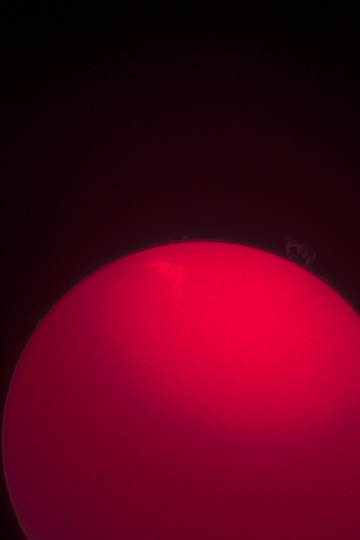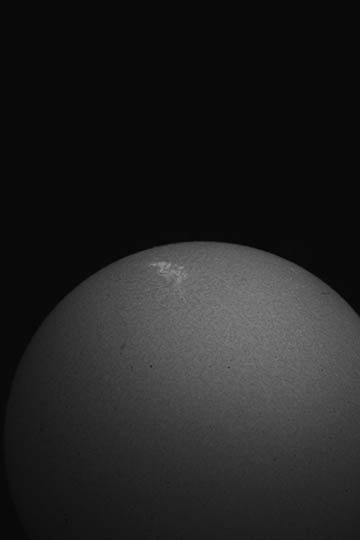|
Staring at the Sun, 9 :: home :: |
|
7/10/2010. Active region 1087 continues to provide a good show. It's by far the most prominent feature on the solar disk, bright and contrasty enough to focus on directly using LiveView in the 50D behind the double-stacked Lunt:
Lunt LS60Ha
with DS50 on A-P Mach1.
I tried some ambitious, barlow-amplified eyepiece projection images, but could not get good focus. The image was utterly invisible without the hood. I saw striking detail on the LCD but could not capture it on the chip, probably because of the 2 second exposures required. I changed up to ISO 2000 and tried again with 1/2 second exposures, but the results were not much better. I think there is just too much turbulence and too little resolution and too little light to push that hard (10.5mm Plossl behind the barlow in the EP kit). The images with the barlow alone on the EP tube were quite good at all exposures from 1/10 to 1 second. That's a 1,220 pixel wide crop from a vertical composition up top. See below for images nearer the starting point, and see below for the arithmetic that says I should stop trying for additional image scale. The 1 second exposures revealed both the intricate disk detail and a large Chinese dragon of a prominence. For solar astrophotography, I've setlled on the unmodified Canon 50D (for its liveview focusing mode) even though the Ha-enhanced 20D would have real advantages. The image out of the camera is 3168x4752 pixels, which, after extracting the red-only plane becomes 1589x2385 pixels. The image above was downsampled from a 1,220 pixel crop. Here's one of the three identically exposed frames used to produce the image above:
It's tempting to try to increase magnification with eyepiece projection or more potent amplifier lenses, but remember that the aperture of the double-stacked telescope is only 50mm, so the theoretic limit of resolution is around 2 arc seconds. To over sample by a factor of 2 would mean one arcsecond per pixel, so a solar diameter (30 arc minutes or 1,800 arc seconds) covering 3,600 pixels should readily capture all that the telescope can show. We're approaching that here. A little more magnification might be in order, but not a lot. It's worth remembering that the detail visible through an eyepiece in the telescope is much closer to that visible in the image up top than in these mostly raw (only lightly processed) frames. I say that in case you're reading this while in the market for a solar telescope. I can't emphasize enough that the visible detail is superb while it does take some care to get images that compare well with the view. This is one way in which solar astrophotography is very different from deepsky astrophotography: in the latter case, photos always show much more than the eyepiece does; in the former, the challenge is to capture all that you can see. Judicious cutting, cropping, and sharpening lifts this close-up of the plasma fields above Sunspot 1087 from the same single image:
Many more frames would produce smoother tones and likely extract better detail. This shows 90% of what I could see in the eyepiece but without the subtlety and ruby beauty of it all. The finest images of spot 1087 (none of mine!) show bunches of spicules bending in the solar magnetic field like clumps of wheat bending under a prairie wind. The detail seems boundless, the tones unlimited. What does it take to get that? A monochrome sensor and tens or hundreds of frames? A bigger aperture? Both? Or just better processing technique. Working on it. 7/11/2010. Calm air and nailing the focus is a lot of it: see next page! |
:: top ::
© 2010, David Cortner



